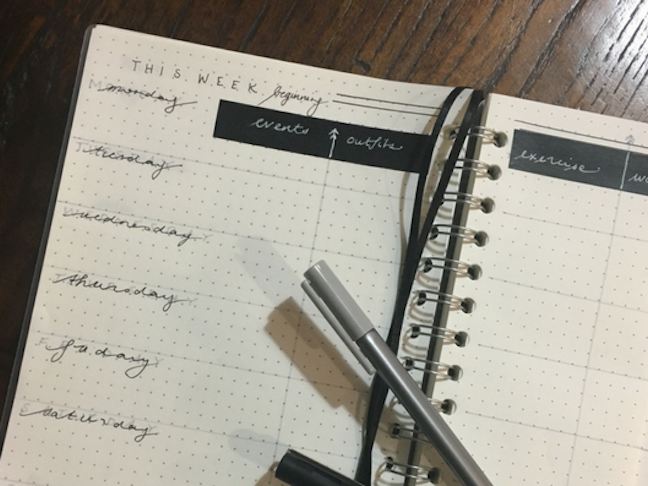My life resides in my hand bag, between the covers of my bullet journal. Goals, dreams, appointments, to-do lists and reminders, all contained within its pages. In one place.
Bullet journaling combines my love of planning, lists, stationery and creativity in one useful package.
For the uninitiated, a bullet journal is a flexible, analog system that allows you to plan your life. Basically, it’s comprised of a note book, a few pens and your imagination, limited by a few parameters. The use of an index enables you to find pages easily and the ability to promote, demote and revise tasks. The best visual explanations are found here.
I use my journal primarily as a yearly, monthly and weekly planner. Because of its flexible structure, it adds a lot more depth (and space) to my planning than a regular diary. I can depart from day-to-day planning and use it to set out goals, or use it to reflect on what has passed. I also use it as a way to track the never-ending sport, school and social obligations of my kids.
Recently I attended a fabulous seminar on time management. The speaker talked about how we often fail at managing our time because we use so many tools to do so. We use our email as bring-up system, we send ourselves reminder texts, we scribble on scraps of paper and rely on dozens of other things desperately containing all we need to do. Shifting to a consolidated system can drastically improve things.
For me, bullet journaling provides that comprehensive approach. It becomes my single source of truth. So while I will keep the email regarding a bill for reference purposes, the due date and the amount go into the bullet journal. Dates from newsletters and school bag notes are entered immediately into the journal.
Commitments made via text go straight into the journal. If I promise the kids a fun outing because they did their chores without complaint, it goes in the journal. You get my drift.
Sometimes ideas or opportunities come into my life that cannot be scheduled against a specific day. They might still be vague or comprised of several tasks that I need to figure out. In that case, I can use the yearly or monthly planner pages to note them.
This is another thing I love about bullet journaling. It allows for the constant zooming out and zooming in. It accommodates the bigger picture while allowing you to break that bigger picture down into small, achievable tasks. In both my work and my day to day life, I find that I am constantly having to shift focus and it’s helpful to have a tool that supports that reality.
I find peace of mind in handing my tasks over to paper. My overflowing brain doesn’t have to hold the information when I have this receptacle at my fingertips. My journal holds it for me in a structured and liberating way — just like I have one place to keep my keys, it’s become the one place I keep my mental load.
So much has been written about how women bear the brunt of that load. Mum is the person who holds all the information about everyone, and who plans all the things, and then actually does most of the things. Keeping a bullet journal allows me to keep on top of it all, and it helps me share that with the rest of the family. It’s not a secret journal. My husband is welcome to it. The kids can see it.
For families in particular it can be useful to bullet journal the following:
- Books read together
- If you use a weekly chore chart/reward system you can move that into your journal
- If your child is a keen sportsperson, you can record their stats, personal bests and goals
- Meal planning (and reviews of what was a hit)
- Recording milestones for the little ones
- Birthday lists as well as gift ideas for family and friends – noting what you bought (and where you hid it!)
- Holiday ideas and plans to get away
- Screen time tracker
- Assignment and homework planning
- Family bucket list
- School holiday planning ahead of time
This is a sample of my general weekly layout, which covers basic events, my exercises and water goals, outfit planning, the weekly menu plan, the household spend and a place to remember gratitude.


I like using the “Dutch Fold” to expand the space available for planning. You can do this vertically or horizontally. Here’s a great article explaining how.
If you are keen to start journaling, here are a few tips:
- Large stationers and bookstores have different sized dotted notebooks that I find perfect for bullet journaling. I think it’s helpful to use a size that will fit into your handbag
- Adding a few ribbons as bookmarks is a handy way of keeping your place — if you buy a spiral bound notebook you can easily attach them
- Create a Pinterest board and collect those bullet journal layouts that appeal to you
- Set aside time each week to plan ahead and then allocate small amounts of time each morning to do the same thing
- Keep a pen with the journal at all times, and keep both with you at all times
- Use it as a creative outlet. There are so many beautiful bullet journals filled with gorgeous art. Use it as a way to practice your hand writing, to draw, to collage and to dream. This Facebook page is a great place to start for inspiration
- While being inspired, think about what matters to you — a beautiful layout that monitors things you don’t really care about isn’t valuable.
- If you want a pretty journal, but you don’t feel like you have the flair (or time), there are plenty of great templates available that you can trace over. This is a great free resource.
- Don’t be too precious about it — It doesn’t have to be perfect; it’s designed to be practical.








